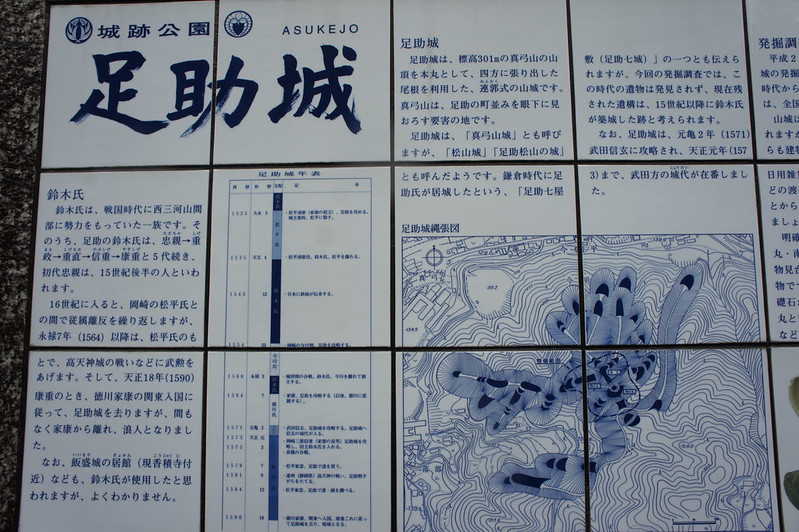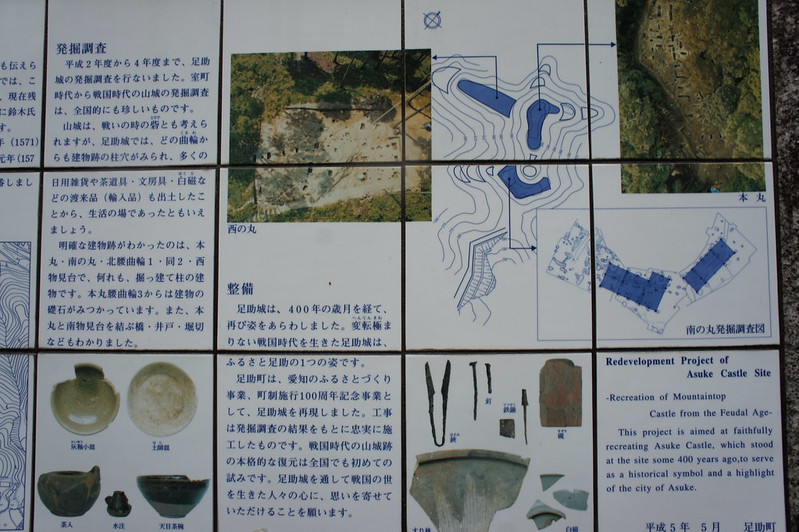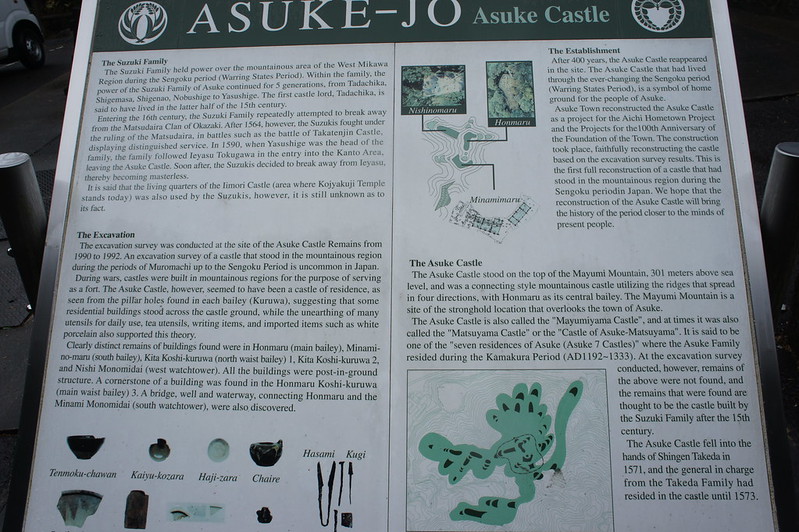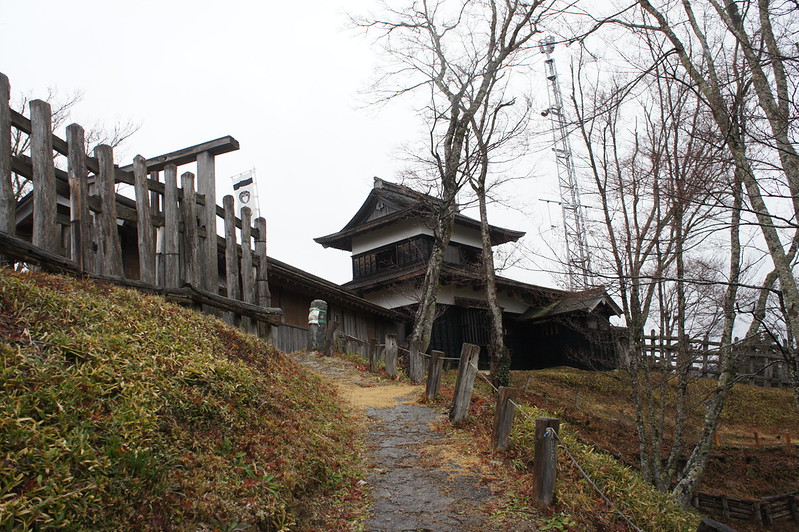足助城の歴史や復元整備についての案内板の内容を紹介します。


足助城
鈴木氏
鈴木氏は、戦国時代に西三河山間部に勢力をもっていた一族です。そのうち、足助の鈴木氏は、忠親(ただちか)→重政(しげまさ)→重直(しげなお)→信重(のぶしげ)→康重(やすしげ)と5代続き、初代忠親は15世紀後半の人といわれます。
16世紀に入ると、岡崎の松平氏との間で従属離反を繰り返しますが、永禄7年(1564)以降は、松平氏にもとで、高天神城の戦いなどに武勲をあげます。そして天正18年(1590)康重のときに徳川家康の関東入国に従って、足助城を去りますが、間もなく家康から離れ、浪人となりました。
なお、飯盛城(いいもりじょう)の居館(現香積寺付近)なども、鈴木氏が使用したと思われますが、よくわかりません。
足助城
足助城は、標高301mの真弓山の山頂を本丸として、四方に張り出した尾根を利用した、連郭式(れんかくしき)の山城です。真弓山は、足助の町並みを眼下に見おろす要害の地です。
足助城は、「真弓山城」とも呼びますが、「松山城」「足助松山の城」とも呼んだようです。鎌倉時代に足助氏が居城したという、「足助七屋敷(足助七城)」の一つとも伝えられますが、今回の発掘調査では、この時代の遺物は発見されず、現在残された遺構は、15世紀以降に鈴木氏が築城した跡と考えられます。
なお、足助城は元亀2年(1571)武田信玄に攻略され、天正元年(1573)まで、武田方の城代(じょうだい)が在番しました。
発掘調査
平成2年度から4年度まで、足助城の発掘調査を行ないました。室町時代から戦国時代の山城の発掘調査は、全国的にも珍しいものです。
山城は、戦いの時の砦(とりで)とも考えられますが、足助城では、どの曲輪(くるわ)からも建物跡の柱穴がみられ、多くの日用雑貨や茶道具・文房具・白磁(はくじ)などの渡来品(輸入品)も出土したことから、生活の場であったともいえましょう。
明確な建物跡がわかったのは、本丸・南の丸・北腰曲輪1・同2・西物見台で、何れも、掘っ建て柱の建物です。本丸腰曲輪3からは建物の礎石がみつかっています。また、本丸と南物見台を結ぶ橋・井戸・堀切などもわかりました。
整備
足助城は、400年の歳月を経て、再び姿をあらわしました。変転(へんてん)極まりない戦国時代を生きた足助城は、ふるさと足助の1つの姿です。
足助町は、愛知のふるさとづくり事業、町制施行100周年記念事業として、足助町を再現しました。工事は発掘調査の結果をもとに忠実に施工したものです。戦国時代の山城跡の本格的な復元は全国でも初めての試みです。足助町を通して戦国の世を生きた人々の心に、思いを寄せていただけることを願います。
Redevelopment Project of Asuke Castle Site
-Recreation of Mountaintop Castle from the Feudal Age-
This project is aimed at faithfully recreating Asuke Castle, which stood at the site some 400 years ago, to serve as a historical symbol and a highlight of the city of Asuke.平成5年5月 足助町
英語の案内板もあります。

ASUKE-JO (Asuke Castle)
The Suzuki Family
The Suzuki Famiry held power over the mountainous area of the West Mikawa Region during the Sengoku period (Warring States Period). Within the family, the power of the Suzuki Family of Asuke continued for 5 generations, from Tadachika, Shigemasa, Shigenao, Nobushige to Yasushige. The first castle lord, Tadachika, is said to have lived in the latter half of the 15th century.
Entering the 16th century, the Suzuki Family repeatedly attempted to break away from the Matsudaira Clan of Okazaki. After 1564, however, the Suzukis fought under the ruling of the Matsudaira, in battles such as the battle of Takatenjin Castle, displaying distinguished service. In 1590, when Yasushige was the head of the family, the family followed Ieyasu Tokugawa in the entry into the Kanto Area, leaving the Asuke Castle. Soon after, the Suzukis decided to break away from Ieyasu, thereby becoming masterless.
It is said that the living quarters of the Iimori Castle (area where Kojyakuji Temple stands today) was also used by the Suzukis, however, it is still unknown as to its fact.
The Excavation
The excavation survey was conducted at the site of the Asuke Castle Remains from 1990 to 1992. An excavation survey of a castle that stood in the mountainous region during the periods of Muromachi up to the Sengoku Period is uncommon in Japan.
During wars, castles were built in mountainous regions for the purpose of serving as a fort. The Asuke Castle, however, seemed to have been a castle of residence, as seen from the pillar holes found in each bailey (Kuruwa), suggesting that some residential buildings stood across the castle ground, while the unearthing of many utensils for daily use, tea utensils, writing items, and imported items such as white porcelain also supported this theory.
Clearly distinct remains of buildings found were in Honmaru (main bailey), Minami-no-maru (south bailey), Kita Koshi-kuruwa (north waist bailey) 1, Kita Koshi-kuruwa 2, and Nishi Monomidai (west watchtower). All the buildings were post-in-ground structure. A cornerstone of a building was found in the Honmaru Koshi-kuruwa (main waist bailey) 3. A bridge, well and waterway, connecting Honmaru and the Minami Monomidai (south watchtower), were also discovered.
The Establishment
After 400 years, the Asuke Castle reappeared in the site. The Asuke Castle that had lived through the ever-changing the Sengoku period (Warring States Period), is a symbol of home ground for the people of Asuke.
Asuke Town reconstructed the Asuke Castle as a project for the Aichi Hometown Project and the Projects for the 100th Anniversary of the Foundation of the Town. The construction took place, faithfully reconstructing of a castle that had stood in the mountainous region during the reconstruction of the Asuke Castle will bring the history of the period closer to the minds of present people.
The Asuke Castle
The Asuke Castle stood on the top of the Mayumi Mountain, 301 meters above sea level, and was a connecting style mountainous castle utilizing the ridges that spread in four directions, with Honmaru as its central bailey. The Mayumi Mountain is a site of the stronghold location that overlooks the town of Asuke.
The Asuke Castle is also called the "Mayumiyama Castle", and at times it was also called the "Matsuyama Castle" or the "Castle of Asuke-Matsuyama". It is said to be one of the "seven residences of Asuke (Asuke 7 Castle)" where the Asuke Family resided during the Kamakura Period (AD1192 - 1333). At the excavation survey conducted, however, remains of the above were not found, are thought to be the castle built by the Suzuki Family after the 15th century.
The Asuke Castle fell into the hands of Shingen Takeda in 1571, and the general in charge from the Takeda Family had resided in the castle until 1573.


